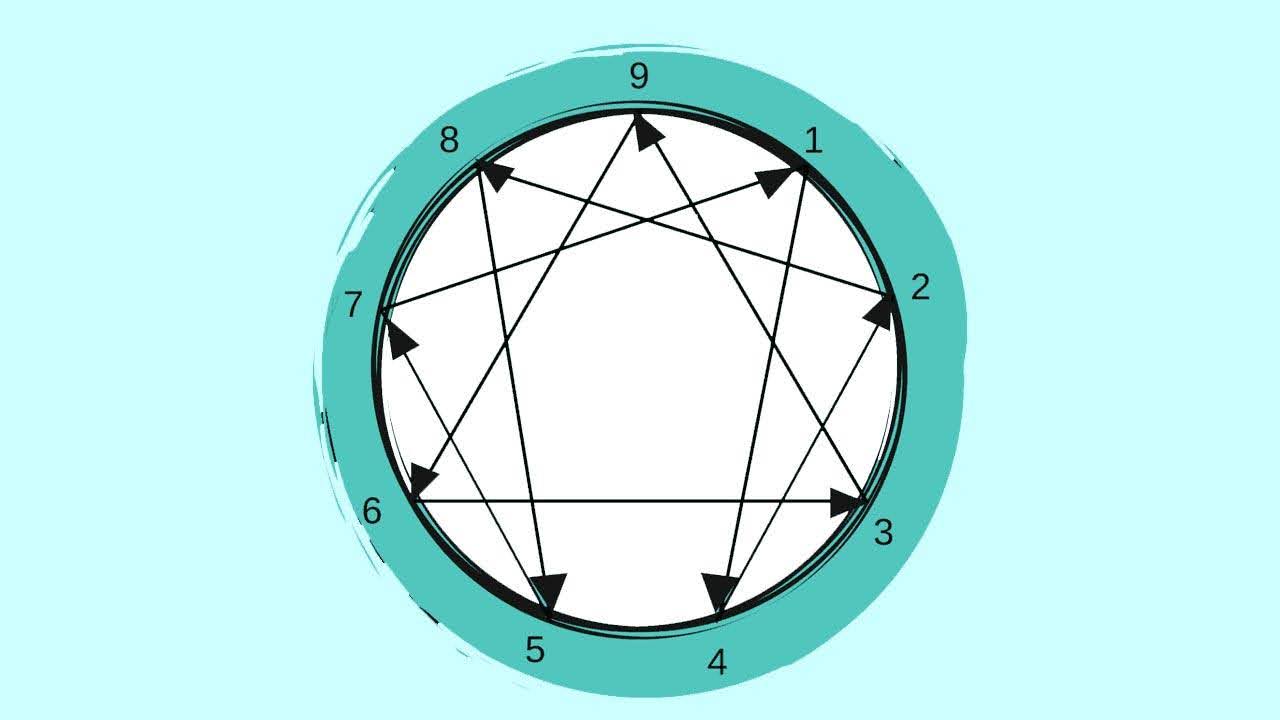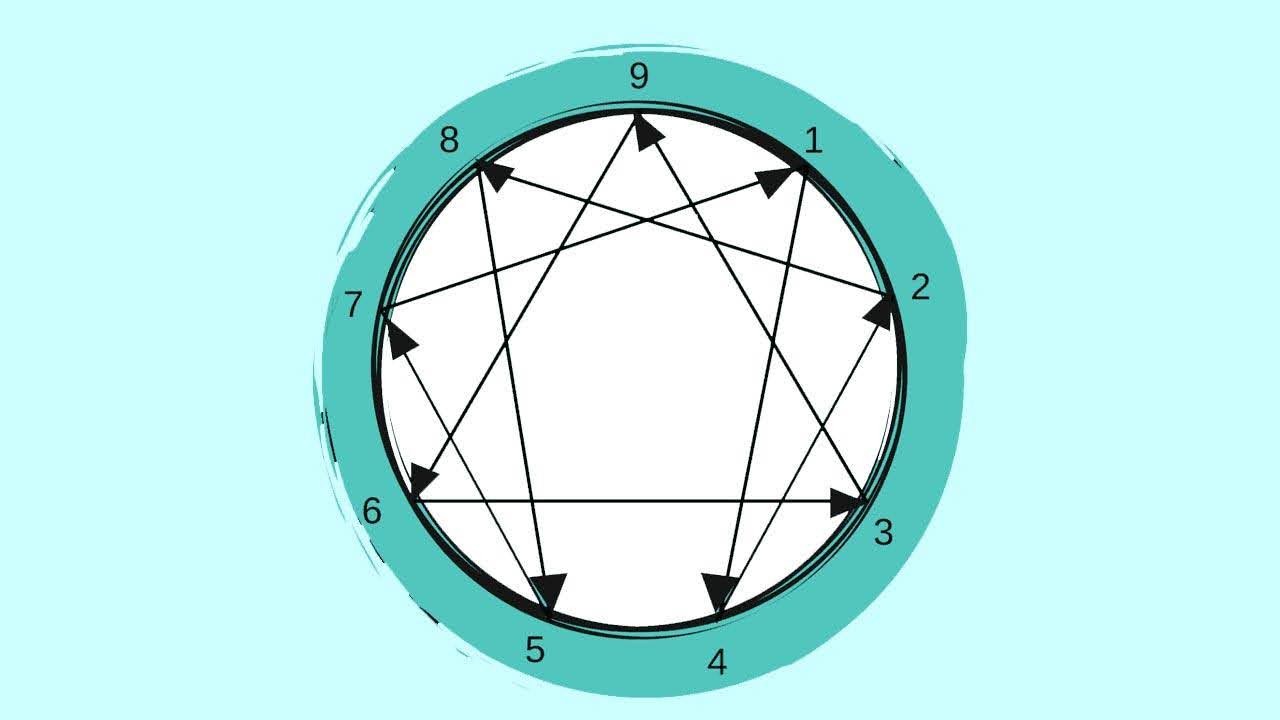Enneagram arrows illustrate the interconnectedness and growth patterns between different personality types. They are a fundamental part of the Enneagram, along with other chief components like core type, wings, triads, etc., offering a valuable tool for self-awareness and self-development. These arrows help us discover new aspects of ourselves, especially during stress and growth times, and provide valuable insights into how we respond to challenges and opportunities for personal growth.
What Are Enneagram Arrows?
Enneagram arrows, to put it simply, are the lines within the Enneagram circle that connect each of the nine primary types to two other types. They express the Direction of Stress and Direction of Growth, representing how a person will likely act and behave in different scenarios and how they can access the qualities of other types for growth and balance.
All nine primary types of the Enneagram have an arrow pointing towards it and an arrow pointing away from it, often referred to as growth and stress paths, respectively.
Looking at the Enneagram diagram with arrows below can help you better understand the movement or direction in which individuals may shift under different circumstances.
For example, when experiencing growth, a Type Eight (the Challenger) will likely exhibit the healthy traits and characteristics of Type 2 (the Helper). On the other hand, when under a high level of stress, a Type Eight will likely display the unhealthy attributes of Type 5 (the Investigator).


Enneagram Growth Arrows
The Stress arrows, aka the Directions of Growth or Growth Paths, point to the type that represents the tendencies of behavior, thinking, and feeling that a person may exude when experiencing growth and a healthy and balanced state. The sequences of growth arrows in the Enneagram system are 1-7-5-8-2-4-1 and 3-6-9-3.
Thus, again, if identified as an Enneagram Type Two (the Helper), for example, your Direction of Growth is Four (the Individualist). This arrow generally indicates positive traits, qualities, and actions that will result in improvement and development over time. During periods of growth, a Two is likely to exhibit behavior similar to that of a healthy Four, such as becoming better aware of and more honest about their emotions and feelings.
Enneagram Stress Arrows
The Stress arrows, aka the Direction of Stress or Stress Paths, point to the type that represents behavior, thinking, and feeling patterns that individuals are likely to have when they are under stress or not in control of the situation. The sequences of stress arrows are 1-4-2-8-5-7-1 and 3-9-6-3.
This arrow generally indicates a downhill or negative course of action that could result in poor and negative effects on both you and others if it’s not recognized. That means if you are a Type Two, for example, your Stress of Growth is toward Type Eight (the Challenger). In times of stress, a Two tends to behave like an unhealthy Eight, showing traits associated with unhealthy Challengers, like seeking to control or becoming aggressive.
Enneagram Arrows Explained For 9 Personality Types
Here’s a brief look at how each personality type within the Enneagram system responds to stress and growth.
Enneagram 1 Arrows
- Under stress: Type One, the Perfectionist, moves along the Enneagram arrow to Type Four (the Individualist). Stress impacts Type 1s with the tendency to become overly critical and self-conscious.
- When feeling secure & experiencing growth: During growth, the Ones’ growth arrow points towards Sevens (the Enthusiasts). This shift allows them to loosen their rigid standards, becoming more spontaneous, playful, open-minded, and able to enjoy fun.
Enneagram 2 Arrows
- Under stress: Type Two, the Helper, sees their stress arrow leading to Type Eight (the Challenger). Stress can cause Twos to become more aggressive, controlling, and confrontational, particularly when they don’t feel appreciated.
- When feeling secure & experiencing growth: Twos’ growth arrow guides them toward Type Four (the Individualist). They become more transparent and can embrace authenticity and self-awareness. These individuals can also be better aware of their emotions and truly honest about what they feel.
Enneagram 3 Arrows
- Under stress: Type Three, the Achiever, moves to Type Nine (the Peacemaker) when stressed, likely becoming avoiding, passive-aggressive, and struggling with decision-making and taking action.
- When feeling secure & experiencing growth: Type Three leans into Type Six (the Loyalist). They value loyalty, trust themselves and others, and become more committed and willing to stand for what they truly believe in.
Enneagram 4 Arrows
- Under stress: Fours, when stressed, may resemble unhealthy Type Two (the Helper). They tend to be codependent and attention-seeking and become overly dependent on others for validation.
- When feeling secure & experiencing growth: Twos integrate the qualities of Type Ones (the Perfectionists), embodying discipline, integrity, and purpose. They are likely to act to the ideals of their own and become less self-absorbed and more objective.
Enneagram 5 Arrows
- Under stress: Type Five, the Individualist, moves to Type Seven (the Enthusiast). Stress may cause people of this type to exhibit traits like becoming impulsive, easily distracted, and withdrawn by spending a lot of time seeking new experiences or what they find interesting.
- When feeling secure & experiencing growth: Fives move towards the Type Eights (the Challengers) in times of growth, embodying assertiveness, decisiveness, and leadership. They will likely engage more fully with the world around them, exuding more energy and action, as well as becoming more willing to take the initiative and confidently pursue their goals.
Enneagram 6 Arrows
- Under stress: Type Six (the Loyalist) moves along the Enneagram arrow to Type Three (the Achiever). Stress and an out-of-balance state can cause Loyalists to seek to impress others and tend to feel anxiety about failure and a loss of self-identity.
- When feeling secure & experiencing growth: Sixes’ growth arrow points towards Nines (the Peacemakers). They can develop inner peace, trust, and acceptance, becoming more trusting not only themselves but also other people rather than suspecting their motives.
Enneagram 7 Arrows
- Under stress: Type Seven (the Enthusiast) can exhibit traits of Type One (the Perfectionist) when unhealthy, becoming more critical, perfectionistic, and judgmental. Stress can cause Type 7s to engage in fault-finding, self-criticism, and even blaming others.
- When feeling secure & experiencing growth: Sevens’ growth arrow guides them toward Type Five (the Investigator), becoming more focused and introspective. They can embrace both the positive and negative, the joyful and the sorrowful parts of life.
Enneagram 8 Arrows
- Under stress: Type Eight (the Challenger) moves to Type Five (the Investigator), likely resembling unhealthy traits like withdrawing, isolating, and becoming overly analytical.
- When feeling secure & experiencing growth: Eights move towards type Twos (the Helpers), able to connect more deeply with others with warmth and compassion. They also become more caring and nurturing toward others.
Enneagram 9 Arrows
- Under stress: Type Nine (the Peacemaker) sees their stress arrow leading to Type Six (the Loyalist). They may display characteristics of Type Six when unhealthy, such as indecisiveness and a sense of being overwhelmed by doubtfulness and anxiety.
- When feeling secure & experiencing growth: Nines can take on attributes of a healthy Type Three (the Achiever), becoming more confident, productive, practical, focused, and driven towards their goals.
3 Tips for Using Enneagram Arrows to Enhance Personal Growth
The Enneagram arrows can be considered a roadmap for personal development, guiding each type towards a healthier version of themselves. By exploring and understanding both the stress and growth arrows, we may gain a deeper insight into our behavior, motivations, challenges, and growth potential that naturally go with our primary Enneatype.
Using Enneagram arrows for growth begins with self-awareness and a willingness to delve into the depths of your personality.
Assuming that you have identified your Enneagram type, the following are three basic tips on how to use these arrows for self-improvement that you may find helpful:
- Be aware of the negative patterns associated with your stress path. Notice your behavior when stressed. Are you becoming critical like a stressed One (if you're a Seven) or withdrawing like a stressed Five (if you're an Eight)? Recognizing these patterns is the initial step toward change and improvement. Additionally, you may also want to seek feedback from trusted friends or mentors to gain insight into areas where you may be resisting growth or falling back into stress patterns.
- Embrace the qualities associated with your growth direction. Study the characteristics of your growth type. What are their strengths? How can you integrate those qualities into your life? For example, a Type Five might learn assertiveness from their growth point, the Eight.
- Practice makes progress. Actively cultivate qualities, strengths, and skills of your growth type. For instance, a stressed Nine might find comfort in being focused and taking decisive action like a healthy Three. Still, remember that personal growth is a gradual and ongoing process, so don’t be in a rush to improve yourself. Instead, celebrate small wins and be patient with yourself along the way.
Enneagram arrows, which indicate the lines of integration and disintegration and suggest potential growth paths and areas of stress for each personality type, offer a framework for understanding personal growth. Still, while they can offer valuable insights, it's essential to use these arrows as guidelines rather than strict rules, as misinterpretation or over-reliance on them could lead to misunderstandings or inaccuracies in self-analysis or understanding others.
It's also worth noting that no single aspect of the Enneagram system can fully capture the complexity of human personality, and individuals may not always precisely align with the growth paths or stress responses described by the Enneagram arrows. Therefore, though Enneagram arrows can be a helpful tool for personal growth and understanding, it's recommended to approach them with an open-minded perspective.
Conclusion
The Enneagram arrows serve as a valuable roadmap for personal growth and self-awareness. They show how each type behaves during growth times or when stressed, as well as how individuals can grow and learn from the other types. By following the arrows, you can discover new aspects of your personality, develop a more balanced and holistic way of being, and embrace your true potential.
On our website, you can read more useful articles, one of which is Insights Into Enneagram Type Sixes in Relationships & Enneagram 6 Compatibility.
![]()
